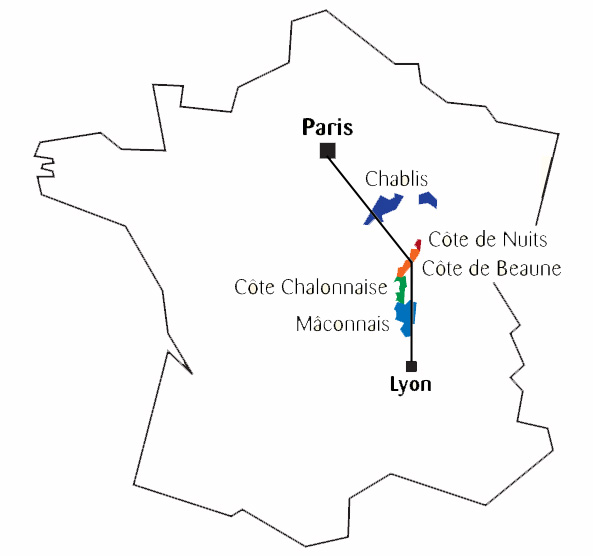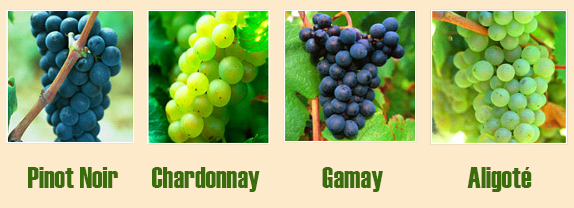Location, Facts and figures
Burgundy is an administrative region of France situated to the East of central France. Beaune, the wine “capital” of Burgundy, is about 330km (about 200 miles) South-East from Paris. Geneva (Switzerland) and Lyon are about 225km (about 140 miles) and 150km (about 100 miles) respectively from Beaune.
Distances and travel times in Burgundy (and France generally) can be deceptively large and long. For example, Chablis is 150km (nearly 100 miles) from Beaune and more than a 90 minute drive. Macon is about a one-hour drive. Travel times can be particularly long away from the main autoroutes.
Wine regions of Burgundy
Burgundy is divided into five wine regions

Chablis and Auxerrois – mainly white wines around the village of Chablis with reds near the town of Auxerre
Côte de Nuits – mainly reds from world-renowned villages such as Gevrey Chambertin, Chambolle Musigny, Vosne Romanée and Nuits St Georges. Here we find many of the great red wines of Burgundy.
Côte de Beaune – a mixture of red and white wine from villages such as Savigny-lès-Beaune, Pommard, Meursault, Puligny-Montrachet and Chassagne-Montrachet. Here are some of the greatest white wines.
Côte Chalonnaise – red and white wines and the “hidden secret” of Burgundy. Wines from villages such as Rully, Givry and Mercurey.
Maconnais – mainly white wine such as Pouilly Fuissé, St Veran and Macon villages.
Size
Burgundy is one of the world’s greatest and most prestigious wine regions but it is surprisingly small representing just 3% of the vines planted in France. The distance from Dijon in the north to Macon in the south is just 120km (about 75 miles). The Chablis area, which is geographically on a limb, is halfway between Beaune and Paris.
27,700 hectares (69,000 acres) of vines cultivated
200 million (approx) bottles produced each year, just 3% of the production of France and around 0.3% of the world’s wine production
Nearly 4,000 independent winegrowers
250 Négociants (merchants)
23 Caves co-operative
The grape varieties
Burgundy wine is usually produced from a single grape variety (called mono-cépage) and is with very few exceptions:
Chardonnay for white wine
Pinot Noir for reds
Aligoté a white grape variety found mainly in Burgundy
Gamay, while the predominate variety for Beaujolais, is also grown here.
61% of Burgundy wine is white, 30% red, 8% is the sparkling wine of Burgundy, Crémant de Bourgogne and 1% rosé.

Appellation system
Burgundy has 100 different Appellations d’Origine Controlée (AOC) wines. Think of this as an address label, indicating the place where the grapes have been grown.
Burgundy wines are divided into four classifications.
52% of production (23 appellations) is Regional Burgundy wine, which means the wine can come from a number of different plots throughout the Burgundy area carrying Regional classification
35% of wine (44 appellations) is classified as Village (Communal) which means the grapes must be grown in and around the village named on the bottle; e.g. Nuits St Georges, Meursault, Mercurey.
12% is Premier Cru wine which means the grapes will be grown in one single vineyard within the named village. Both the village and vineyard name appear on the bottle; e.g. Vosne Romanée 1er (Premier) Cru Les Suchots
2% (33 appellations) is Grand Cru wine where just the vineyard name appears on the bottle (e.g. Clos de Vougeot Grand Cru)
Terroir – the essence of Burgundy
Terroir is the essence of Burgundy – and most European wine. Terroir can best be described as recipe of different ingredients resulting from millions of years of geological evolution, comprising the top soil, elevation, angle the vines are planted, micro-climate and lastly but most importantly the underlying subsoil and rock with its multi layers
On our Burgundy Discovery wine tours we expand on this information, take you into the vineyards, meet the growers and taste the wines in an informative and fun manner.
2000 year Burgundy wine history

1st and 2nd centuries AD represent the beginning of the vineyards under Gallo-Roman influence
4th century – first written evidence that vineyards exist in Burgundy
11th century – the Cistercian monks from Citeaux and Cluny develop methods and understanding to cultivate the vines
15th century – The Dukes of Burgundy spread knowledge of Burgundy wines through France and Europe
20th century (1936) – Creation of the first Appellation d’Origine Controlee
21st century – 20,000 men and women work in the Burgundy wine region.
To find out more visit the official Bourgogne wine website Read more.




